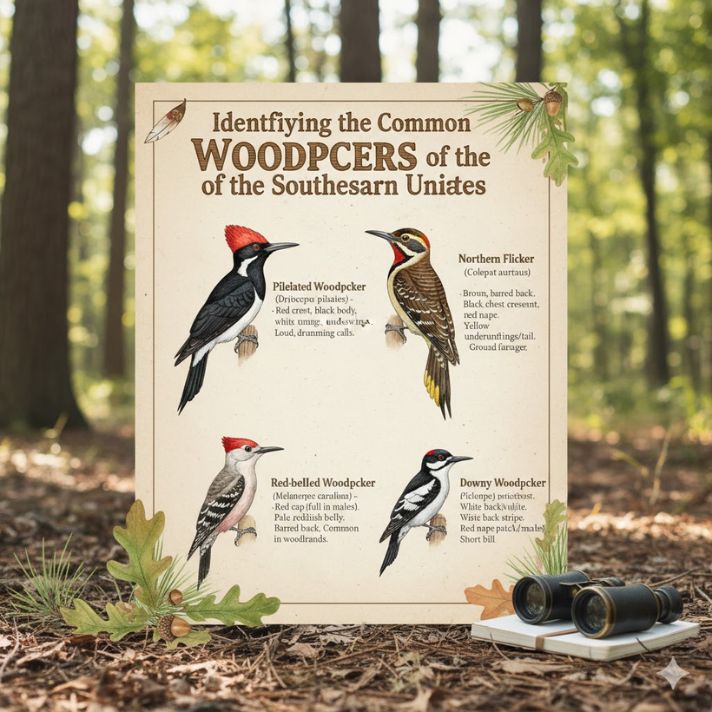If you love watching birds, the Southeastern United States is one of the best places to spot woodpeckers. These colorful and noisy birds are easy to recognize by the way they tap or “drum” on trees. You can often see them in backyards, parks, and forests, especially if you put out bird feeders with suet or nuts.
Each woodpecker species has its own look, size, and sound. Some, like the tiny Downy Woodpecker, are quick and friendly, while others, like the huge Pileated Woodpecker, make a grand entrance with their loud calls and bright red crests. From the Red-headed to the Yellow-bellied Sapsucker, every woodpecker adds a special touch of nature to the Southern landscape.
In this guide, we’ll explore the most common woodpeckers you can find across states like Georgia, Alabama, South Carolina, and Florida. You’ll learn how to identify them, what they eat, and where they like to live. Whether you’re a beginner or a backyard bird lover, these tips will help you enjoy and recognize the amazing woodpeckers of the Southeast.
1. 🟥 The Red-bellied Woodpecker — “Scoob”
Our favorite local woodpecker, affectionately named “Scoob,” is a Red-bellied Woodpecker.
Key Traits:
- Bright red cap with a soft blush on the belly
- Loud, rolling “churr” call
- Loves suet nuggets — especially C&S brand!
Fun Fact: Scoob got his name because he loved gobbling down suet balls so much that we started calling them “Scoob Balls.” Now, we’ve seen three generations of these beautiful birds visiting our feeders each spring.
2. ❤️ The Red-headed Woodpecker — “Woodrow”
Meet “Woodrow,” our stunning Red-headed Woodpecker a bird so striking it inspired the famous cartoon Woody Woodpecker!
Where to Spot:
- Common in Georgia, especially near Marietta and Kennesaw Mountain National Battlefield Park
- Prefers open woodlands and large trees for nesting
Identification Tips:
- Entire head is bright red
- Black-and-white wings with a clean, sharp contrast
- Bold and confident at feeders
3. 💛 The Yellow-bellied Sapsucker
The Yellow-bellied Sapsucker might have a funny name, but it’s a fascinating bird that you can sometimes spot during winter migration.
Characteristics:
- Pale belly with yellowish tint
- Red patch on the forehead
- Prefers colder days with fewer insects
These birds are a bit shy; they’ll often fly off quickly at the slightest sound. If you’re lucky, you might see one grabbing a bite of suet on a windy winter day.
4. ⚫ The Downy Woodpecker — “Robert & Roberta”
Robert and Roberta are our resident Downy Woodpeckers, the smallest woodpecker species in North America.
How to Tell Them Apart:
- Male (Robert): Has a small red patch on the head
- Female (Roberta): No red, only black and white
They’re tiny but tough and love suet-cake feeders. You’ll often see them taking turns with other birds throughout the day.
5. ⚪ The Hairy Woodpecker — “Hairy & Sally”
The Hairy Woodpecker looks almost identical to the Downy, but size is the biggest clue.
Quick Comparison:
| Feature | Downy Woodpecker | Hairy Woodpecker |
| Size | ~6 inches | ~9 inches |
| Bill | Short, dainty | Long, sturdy |
| Sound | Soft “pik” | Sharper “peek” |
In our yard, “Hairy” and “Sally” often share a feeder, giving us great side-by-side views of their differences.
6. 🔴 The Pileated Woodpecker — The Giant of the Forest
When you spot a Pileated Woodpecker, you’ll know instantly this bird is massive. It’s the largest woodpecker in North America and often compared to a small pterodactyl!
Features:
- Bright red crest
- Loud, echoing calls
- Males have red under the beak; females do not
You’re most likely to find them in mature forests like Kennesaw Mountain National Battlefield Park, where there are plenty of large trees for nesting.
7. 🪵 The Northern Flicker — “Norbert” or “Norbie”
Though not a “woodpecker” by name, the Northern Flicker belongs to the same family and often forages near the ground.
Fun to Watch:
- Brownish body with black spots
- Yellow or red underwings (depending on the region)
- Often seen hopping around flower beds or near fallen logs
Our first visitor, Norbie, prefers watching the suet feeder before making his move.
Conclusion
In the Southeastern United States, woodpeckers bring life and sound to our backyards and forests. From the small Downy Woodpecker to the striking Red-headed and the powerful Pileated Woodpecker, each bird has its own charm and behavior. Watching them feed, drum, and interact helps us feel closer to nature.
If you keep your eyes and ears open, you can spot these beautiful birds in parks or even right outside your window. So, grab your binoculars, hang some suet feeders, and enjoy the fascinating world of woodpeckers that make the Southeast such a wonderful place for bird lovers.
FAQ’S
1. What are the most common woodpeckers in the Southeastern United States?
The most common include the Red-bellied, Red-headed, Downy, Hairy, Pileated Woodpecker, and the Yellow-bellied Sapsucker each easily spotted around backyards and forests.
2. How can I attract woodpeckers to my backyard?
Offer suet cakes, suet nuggets, peanuts, or mealworms. Provide large trees for nesting and avoid pesticides to create a safe feeding area.
3. What do woodpeckers eat besides suet?
Woodpeckers also eat insects, tree sap, nuts, and berries. They love foraging for bugs in tree bark and visiting feeders during cooler months.
4. Where is the best place to see woodpeckers in Georgia?
Places like Kennesaw Mountain National Battlefield Park and forested neighborhoods in Marietta or Duluth offer great chances to spot multiple woodpecker species.
5. Are woodpeckers harmful to trees or homes?
Most woodpeckers only peck trees for food or nesting. They rarely damage healthy trees or houses unless insects are already present.



